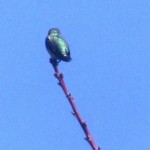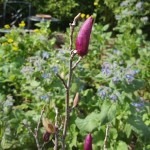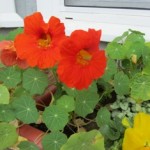Helping the Hummers Refuel
In a single day of darting to and from colorful flowers, the tiny hummingbird consumes nearly half its weight in sugar as it searches for nectar-rich blossoms.

A hummer’s iridescent feathers shimmer as it perches in sunlight at the end of an apricot tree branch
Their wings beat so rapidly, they make a purring sound. Ever industrious, these tiny birds work from dawn to dusk. They are drawn to tubular-shaped flowers or brightly colored ones in shades of red, orange, blue, and pink.
If you want to help the hummers refuel, consider putting flowers on your patio or in your garden that appeal to these little energy burners. Or, better still, plant trees, vines, perennial, and annual plants that will produce the flowers that attract hummers. Choose from the list below.

Behind the unfurled buds of the Jane magnolia are the blue blossoms of Borage, an herb frequented by bees, butterflies, and hummers
Annuals: Borage (blue star flower), impatiens, flowering tobacco, petunia, plox, salvia, and snapdragon
Perennials: aloe, alstomeria, bee balm, California fuschia, cardinal flower, columbine, coral bells, foxglove, gladiolus, parrot’s beak, monkey flower, salvia, and sage
Vines: blood red trumpet vine, cape honeysuckle, lonicera (honeysuckle), flame vine, and trumpet creeper
Trees: acacia, chinaberry tree, citrus, coral tree, eucalyptus, silk tree, and tulip tree
______________________________________________________________________
If you enjoy reading about gardening, keeping chickens and bees, and other backyard farming topics, check out my series of cozy mysteries, including A BEELINE TO MURDER, THE MURDER OF A QUEEN BEE, and A HIVE OF HOMICIDES (Kensington Publishing, NY)
A HIVE OF HOMICIDES
Murder of a Queen Bee
A Beeline to Murder
Attracting Butterflies into Your Garden

The Western Tiger Swallowtail, shown here on geraniums, resembles its counterpart, the Eastern Tiger Swallowtail
While sipping my morning coffee today, I spotted a Western Tiger Swallowtail butterfly in my garden. So naturally, I had to put down my mug of coffee and grab my camera.
These beauties have wingspans stretching up to four inches. The butterflies are often seen in woodlands around streams and riverbanks or canyons in the west. For a complete list of butterflies for Northern California, see http://www.thebutterflysite.com/california-butterflies.shtml
Here on the farmette, these beautiful butterflies feed on the nectar of the garden plants. I often see them on the blooms of my hedge of lavender and elsewhere on the zinnias. They also flit over and and perched on the water fountain near where I grow roses and wisteria.
You can attract these particular butterflies into your Northern California gardens by planting petunia, Mexican sunflower, dianthus, and the butterfly bush. But do a little research on creating a butterfly garden if you want to attract different types of butterflies. And don’t use pesticides or insecticides if you are serious about creating such a haven.
 Facebook
Facebook Goodreads
Goodreads LinkedIn
LinkedIn Meera Lester
Meera Lester Twitter
Twitter





